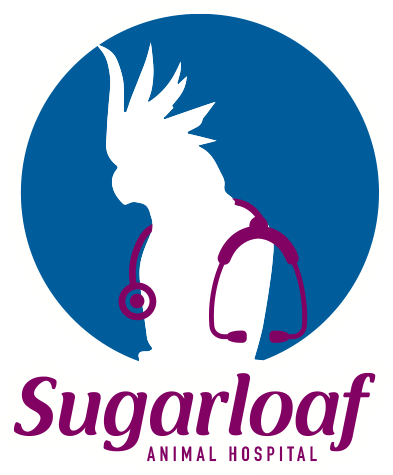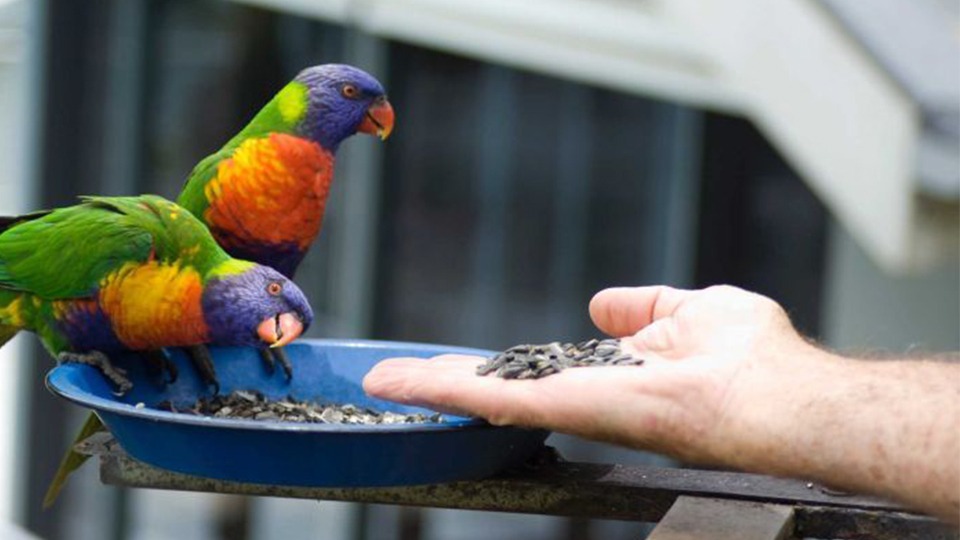While working as a veterinarian and an animal health and welfare advocate, I make a big effort to upset people as little as possible. But one topic I discuss is more likely to upset good people more than any other. Feeding wildlife!! There is no doubt it makes people feel really good, but it is almost always really bad for the birds or animals.
So it has always been the recommendation of the Sugarloaf Animal Hospital that feed stations should NOT be used to attract wildlife, and especially wild birds to gardens. Why? Let’s focus on birds.
It is exceedingly difficult and expensive to provide high quality diets to birds. What is good nutrition for one species is rarely good for another. The amount of salt present in bread and processed foods is not present in natural diets, and puts immense stress on the kidneys. Fat is very limited and of very specific types in most natural diets. Wild bird seed mixes include rapeseeds of oats, corn, (both high in starch, which when moistened or old promotes fungal growth), and sunflower seed. Sunflower seed is very high in fats (also known as oils or lipids), often greater than 55%, which makes the seed very tasty and somewhat addictive. however it can disturb absorption of nutrients and quickly contributes to liver disease. While it is very palatable there are few circumstances where it is an important dietary item. We often recommend not feeding to birds it all!
Feed stations usually become a focal point visited by large numbers of feral birds (domestic pigeons, doves, mynah birds and others) and robust native species (galahs, rosellas, lorikeets and others). The physical proximity of species that would rarely be so close encourages the spread of disease. A particular example is “beak and feather” disease virus PBFD, which causes so much illness and death in our white cockatoo species here in West Wallsend and Holmesville. PBFD is more easily transmitted by the high concentration of virus particles and susceptible individuals at feed stations. There are also many other infectious diseases which are spread feed stations which cause many birds to die a slow and painful death. Some of these are zoonoses and so are potentially dangerous to people.
In addition to infectious diseases, there are a variety of nutritional diseases, which are the direct result of providing food. There is a bleeding disorder that occurs in lorikeets and honeyeaters, which is the result of a lack of pectin in artificial honey diets, a compound which is found in nectar of flowers. Lorikeets and honeyeaters also have an annual cycle of varying concentrations of carbohydrates (starches and sugars) and proteins which contribute to the normal breeding cycle, and healthy rearing of the young. Young fed nectivorous species fed inadequate artificial diets can develop nervous system diseases, and end up paralysed. Many people provide meat for kookaburras or magpies. Of course meat is woefully inadequate in the proportion of calcium it provides and many young of these birds can grow to develop rickets, and soft bones.
Birds often become dependent on the provision of food, and lose the ability to forage effectively for themselves. This is especially so for birds that have been reared to this type of feeding by their parents, and are therefore not taught the intricacies of finding food in the natural environment. There can also be other alterations to bird’s behaviour: since attending the feeding station means coming into contact with a much higher number of birds than otherwise would be the case, there is a marked increase in interspecific aggression. This may lead to injuries, or more commonly a simple increase in stress, which lowers immunity and further encourages disease. Lowered fear response to the presence of humans, cats, and dogs increases the likelihood of an adverse encounter with one of these species.
What about the effects on the environment? Many Australian plants can only be fertilised by particular birds, and other plants require passage of the fruit through the gut of birds before their seeds are fertile. The Australian environment is intricate and complex, and the effects on one particular species cascade through ecosystems to cause severe and permanent changes. A classic example is the changes in gardening in the Newcastle area which have favoured the pied currawong. The large numbers of these lovely native birds that have resulted have decimated the populations of smaller birds, and at the same time provided a new population of hosts for the migratory, parasitic channel-billed cuckoo. Now, large numbers of this species annually call Newcastle home. The effects of relatively minor changes in bird’s environment can have complicated and unforeseen ramifications on that environment. Agriculture, habitat loss, and feral species have already caused huge amounts of disruption. It would be a tragedy if what little that remains of our natural environment is further disturbed by inappropriate treatment of wildlife.
The best way to attract birds (and other wildlife for that matter) to our gardens is to follow Dr Mark’s three point plan:
1 plant large numbers of locally indigenous native plants of a variety designed to:
- supply flowers, foliage, and seeds for feed;
- attract and tolerate a broad range of insect species;
- provide thick, dense cover to protect smaller species
2 provide permanent water sites, preferably designed to be safe from cats
3 provide as many shelter sites as possible: nest boxes of a number of sizes, made from renewable timber sources are better than hollow logs harvested from the bush (where some animal would make use of them!)
There is no doubt that it requires much more effort to attract birds to our yards using Dr Mark’s 3 Point Plan, but we have to realise that to do any less would be to contribute to the suffering of individual birds, and the damage of our local ecosystem.
Other sources of useful information include:
- The Societies for Growing Australian Plants – in NSW known as: the Australian Plants Society
- And more specifically the Study Group for Wildlife & Native Plants of the APSoc
Books
- Birdscaping Your Garden, by George Martin Adams (Rigby Press, 1982)
- A Garden of Birds, by Graham Pizzey (Angus & Robertson, 1988)
(both of these books are full of information, but unfortunately promote supplementary feeding – read them with a critical eye!)
If you have any additional questions concerning wildlife or any other animal health problem, then remember that you can access the service of the Sugarloaf Animal Hospital by simply telephoning 49551833.



